The Nordic countries produce almost half as much energy as the EU combined, thanks to Norway
In 2020, the Nordic countries produced 280 million tonnes oil equivalent of energy [1]. This corresponds to almost half of the primary production in the EU, 48 percent. Of the Nordic primary production, 75 percent came from Norway. Four out of five Nordic countries were net importers of energy in 2020, with dependency rates between 12 and 45 percent. The exception, Norway, exported 6 times the country’s consumption.
The energy market is one of the most current topics today, mainly due to the war in Ukraine and the consequences this will have on energy supply and prices. How this will affect the Nordic region in the long term remains to be seen, but at this point the war has had an immediate effect on the energy market in Europe. As for the energy supply in the Nordic region, there is a natural occurrence of fossil fuels such as oil and gas. The region also has great opportunities to produce renewable energy such as geothermal energy, hydropower and energy from renewable wastes and biofuels.
Primary production of energy
In 2020, the Nordic countries produced 280 million tonnes oil equivalent of energy [1]. This equals 48 percent of the total primary production [2] of energy in the European union (EU27_2020). In 1990 the energy produced in the Nordic region equalled 23 percent of that of the EU [3].
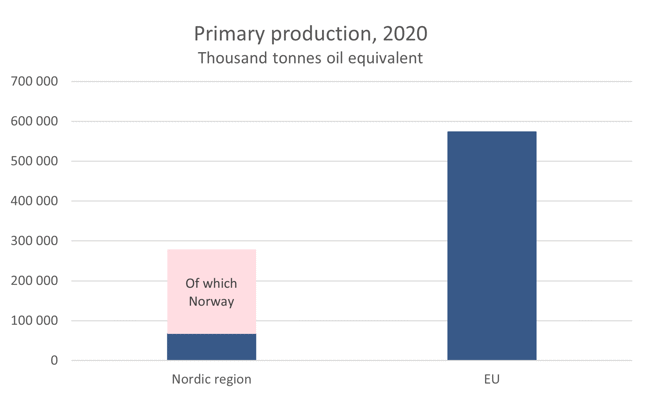
Source: Nordic Statistics Database, ENER06: Primary production of energy by time, reporting country and product.
The primary production of energy in the Nordic countries rose considerably during the 90s, primarily due to the Norwegian oil deposits in the North Sea. At the same time the production in the EU as a whole fell. Since Norway is not a European union member, this increase is not reflected in the figures for the EU.
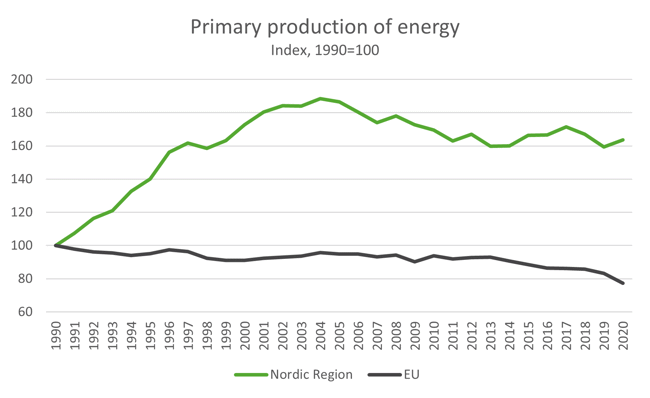
Source: Nordic Statistics Database, ENER06: Primary production of energy by time, reporting country and product.
Most of the Nordic primary production in 2020, 75 percent, was produced in Norway. The other countries produced between 13 and less than 0.5 percent each.
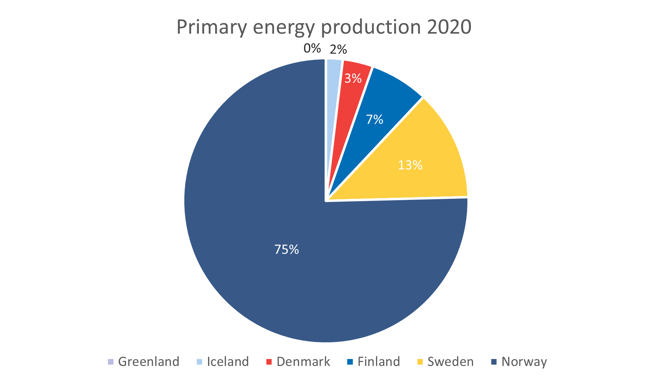
Source: Nordic Statistics Database, ENER06: Primary production of energy by time, reporting country and product.
The most important energy sources in the Nordic countries, measured in terms of primary production are Oil and petroleum products and Gas. They account for about a third of the total primary production each, in million toe (tonnes oil equivalent). Renewables and biofuels account for just over 20 percent, Nuclear heat for 6 percent and the other sources for between 0 and 1 percent each. In the EU, Renewables and biofuels and Nuclear heat are the two largest sources of energy. Together they account for 70 percent of the total primary production, Renewables and biofuels for 40 percent and Nuclear heat for 30 percent.
When analysed by country it is evident that Renewables and biofuels are very important to the Nordic region. The large primary production of Oil and petroleum products and Gas in Norway dominates the Nordic picture. However, it is important to note the fact that all other countries included individually have renewable energy sources accounting for 45 percent or more of the primary production. Greenland and Iceland exclusively produce energy from renewable sources, Hydropower in Greenland and Geothermal energy and Hydropower in Iceland. Renewable wastes and biofuels are the largest sources of renewable energy in Sweden, Finland and Denmark, while Hydropower is the largest in Norway.
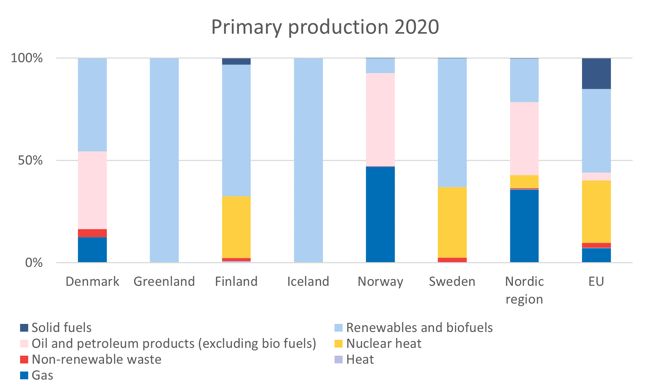
Source: Nordic Statistics Database, ENER06: Primary production of energy by time, reporting country and product.
Gross inland energy consumption
The combined gross inland energy consumption [4] of the Nordic countries, Faroe Islands excluded, was just under 130 million tonnes oil equivalent in 2020 [1]. This equals just under 10 percent of the gross inland energy consumption in the EU. The largest source of energy in the Nordic region in 2020 was Renewables and biofuels, with almost half of the energy consumed coming from this source. Oil and petroleum products accounted for a quarter of the consumption, and Nuclear energy for 13 percent. Compared to the EU the Nordics consume more Renewables and biofuels and less Gas. The latter can be seen as a strength considering ongoing developments.
On top of primary production, the gross inland energy consumption takes into account, among other things, import and export of energy. When analysed by country it can be seen that all Nordic countries consumes energy from sources that they do not produce, which means that they are imported.
Iceland for example, produces only Renewables and biofuels but their Gross inland energy consumption includes Solid fuels and Oil and petroleum products. Only Denmark and Norway produce Gas and Oil and petroleum products, but all countries included in the analysis [5] consume energy from these sources except for Iceland, not consuming gas.
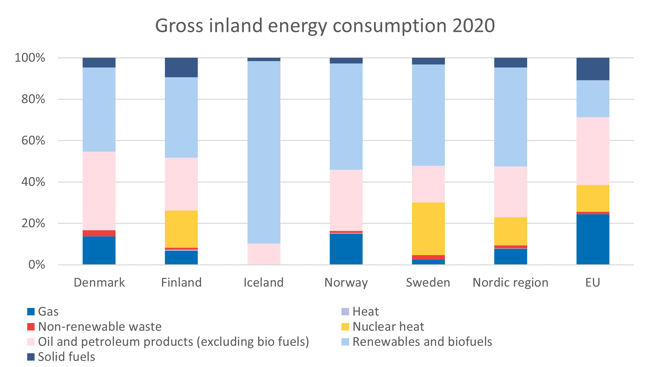
Source: Nordic Statistics Database, ENER06: Primary production of energy by time, reporting country and product.
Energy imports dependency
The energy imports dependency rate shows the proportion of energy that an economy must import. It is defined as net energy imports divided by gross available energy, expressed as a percentage. A negative dependency rate indicates a net exporter of energy while a dependency rate in excess of 100 percent indicates that energy products have been stocked. It can be defined for all products total as well as for individual fuels.
The EU dependency on energy imports did not substantially change over the last decade, from 50 percent of gross available energy in 2010 to 57 percent in 2020. During the presented period, the EU’s net imports of energy have thus been greater than its primary production.
In the Nordic countries, excluding Norway, the energy imports dependency rates today are positive and varies between 12 (Iceland) and 45 percent (Denmark) in 2020. Denmark stands out in the sense that they had negative values, i.e., they were net exporters of energy, between 1999 and 2012. Since then, they have brought an immediate end to new oil and gas exploration in the Danish North Sea as part of a plan to phase out fossil fuel extraction by 2050. Compared with 1990 their rate is on the same level today. The Icelandic rate has decreased by two thirds since 1990, the Finish rate by one third and the Swedish by 12 percent.
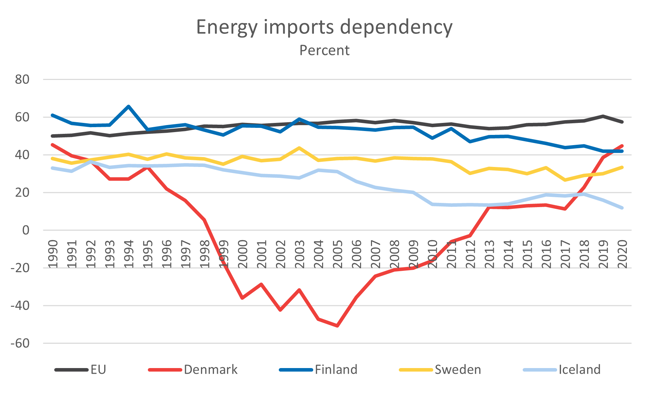
Source: EUROSTAT, NRG_IND_ID: Energy imports dependency
Norway stands out in its role as a major producer of energy, they have been large-scale net exporters throughout the period. In 2020 they exported six times more energy than they consumed, but the rate was as low as -800 percent during parts of the 90´s and early 00´s.
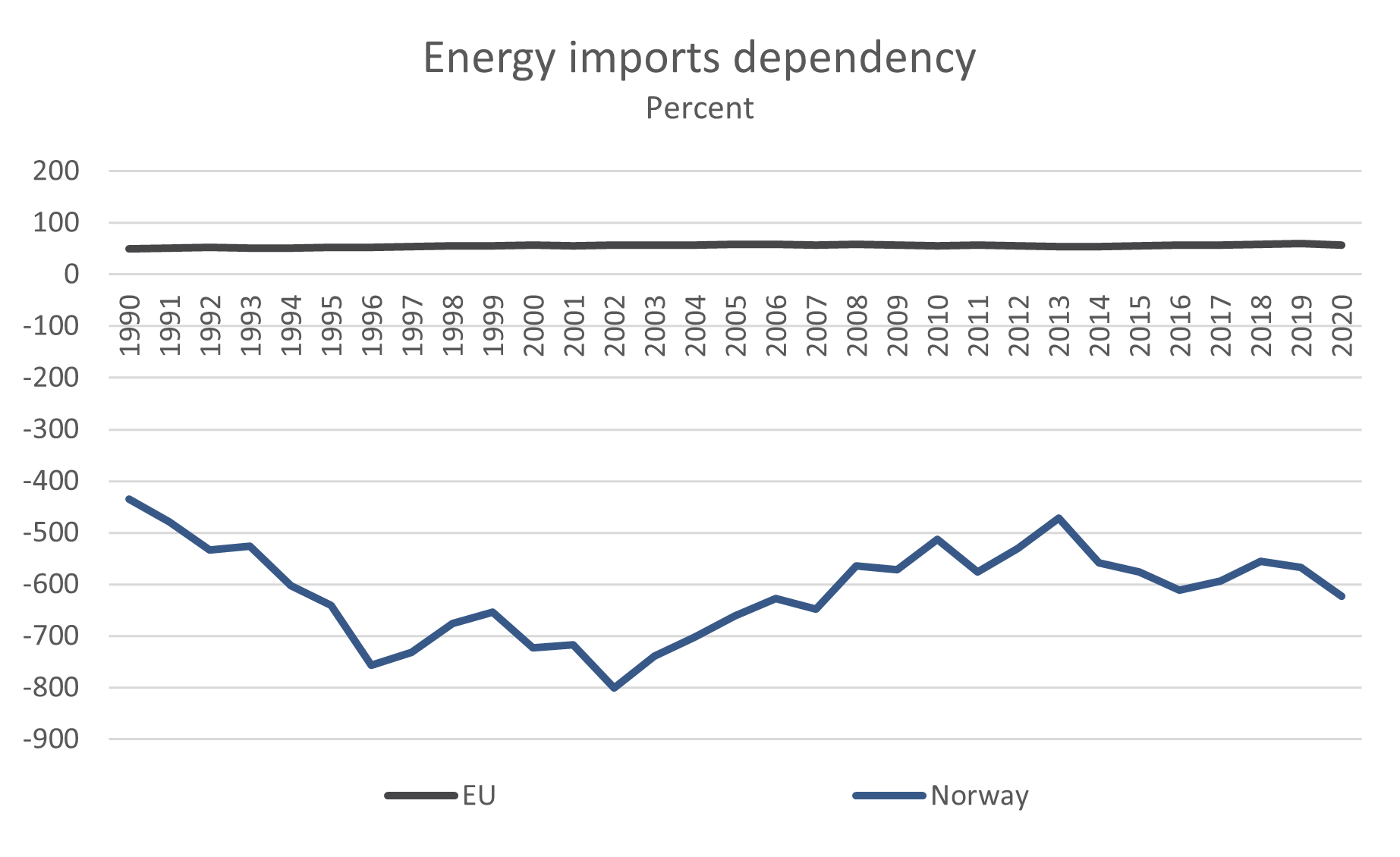
Source: EUROSTAT, NRG_IND_ID: Energy imports dependency
More on energy imports dependancy in the EU can be found here.
[1] No data available for Faroe Islands or Åland, but Åland is included in the data for Finland.
[2] Primary production is the capture or extraction of fuels or energy from natural energy flows, the biosphere and natural reserves of fossil fuels within the national territory in a form suitable for use. Inert matter removed from the extracted fuels and quantities reinjected, flared or vented are not included.
[3] Please note that data for Greenland is missing for 1990. Since their primary production is quite small, it does not affect the comparison between the years 1990 and 2020.
[4] Gross inland energy consumption is the total energy demand of a country or region. It represents the quantity of energy necessary to satisfy inland consumption of the geographical entity under consideration. This aggregate is calculated using the following formula: Gross inland energy consumption = Primary production + Recovered & Recycled products + Imports – Export + Stock changes – International maritime bunkers. For secondary products, which are produced as transformation output in the middle block of energy balances, the Total energy supply can be negative as it reflects only on the trade and stock changes.
[5] Please note that Greenland is excluded as their data on consumption by product is not complete.